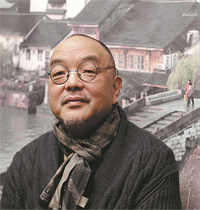

"The West Lake was seen as a picturesque asset that needed to be cared for. But the Grand Canal is like our mother. She has watched us grow up, earn a living along her busy banks, leave her in search of a better future and return to her embrace later on," he says.
Yang Jianxin, former director of the culture department of Zhejiang province, paid an apt tribute in the preface of the picture book Charm of the Grand Canal in Hangzhou published by Wu. "The connection between Hangzhou and the Grand Canal is as inseparable as fish and water. … This is not only because the southern end of the canal flows through half of Hangzhou, but also because it records the history of the city and carries its culture."
Wu has created several collections of canal paintings, such as Eight Scenes of Hangzhou and Xiangfu Flower Festival, and published dozens of books, including Civil Life at the Southern End of the Canal and Painting the Canal.
He also led a team all the way north, creating a panorama of folk customs that prevail along the canal. The spot visit and sketching project lasted for over a year.
Recently, Wu completed a 100-meter-long scroll painting of the canal's Tangxi-Xixing stretch in Hangzhou. He is currently working on another equally long scroll painting in the east and west of Zhejiang province. He will finish it by the end of next year.
"I have actually walked the whole length and painted the entire Grand Canal in Hangzhou, borrowing historical anecdotes from every dynasty," Wu proudly says. "The story of the canal needs to be told and the culture it represents must be passed down."